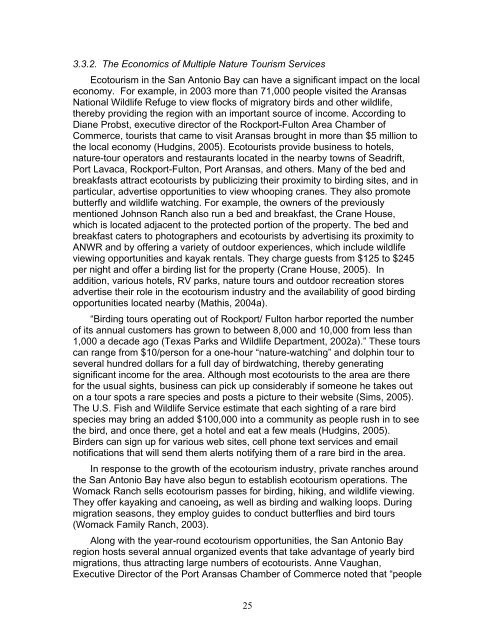The Economic Value of Water and Ecosystem Preservation
The Economic Value of Water and Ecosystem Preservation
The Economic Value of Water and Ecosystem Preservation
You also want an ePaper? Increase the reach of your titles
YUMPU automatically turns print PDFs into web optimized ePapers that Google loves.
3.3.2. <strong>The</strong> <strong>Economic</strong>s <strong>of</strong> Multiple Nature Tourism Services<br />
Ecotourism in the San Antonio Bay can have a significant impact on the local<br />
economy. For example, in 2003 more than 71,000 people visited the Aransas<br />
National Wildlife Refuge to view flocks <strong>of</strong> migratory birds <strong>and</strong> other wildlife,<br />
thereby providing the region with an important source <strong>of</strong> income. According to<br />
Diane Probst, executive director <strong>of</strong> the Rockport-Fulton Area Chamber <strong>of</strong><br />
Commerce, tourists that came to visit Aransas brought in more than $5 million to<br />
the local economy (Hudgins, 2005). Ecotourists provide business to hotels,<br />
nature-tour operators <strong>and</strong> restaurants located in the nearby towns <strong>of</strong> Seadrift,<br />
Port Lavaca, Rockport-Fulton, Port Aransas, <strong>and</strong> others. Many <strong>of</strong> the bed <strong>and</strong><br />
breakfasts attract ecotourists by publicizing their proximity to birding sites, <strong>and</strong> in<br />
particular, advertise opportunities to view whooping cranes. <strong>The</strong>y also promote<br />
butterfly <strong>and</strong> wildlife watching. For example, the owners <strong>of</strong> the previously<br />
mentioned Johnson Ranch also run a bed <strong>and</strong> breakfast, the Crane House,<br />
which is located adjacent to the protected portion <strong>of</strong> the property. <strong>The</strong> bed <strong>and</strong><br />
breakfast caters to photographers <strong>and</strong> ecotourists by advertising its proximity to<br />
ANWR <strong>and</strong> by <strong>of</strong>fering a variety <strong>of</strong> outdoor experiences, which include wildlife<br />
viewing opportunities <strong>and</strong> kayak rentals. <strong>The</strong>y charge guests from $125 to $245<br />
per night <strong>and</strong> <strong>of</strong>fer a birding list for the property (Crane House, 2005). In<br />
addition, various hotels, RV parks, nature tours <strong>and</strong> outdoor recreation stores<br />
advertise their role in the ecotourism industry <strong>and</strong> the availability <strong>of</strong> good birding<br />
opportunities located nearby (Mathis, 2004a).<br />
“Birding tours operating out <strong>of</strong> Rockport/ Fulton harbor reported the number<br />
<strong>of</strong> its annual customers has grown to between 8,000 <strong>and</strong> 10,000 from less than<br />
1,000 a decade ago (Texas Parks <strong>and</strong> Wildlife Department, 2002a).” <strong>The</strong>se tours<br />
can range from $10/person for a one-hour “nature-watching” <strong>and</strong> dolphin tour to<br />
several hundred dollars for a full day <strong>of</strong> birdwatching, thereby generating<br />
significant income for the area. Although most ecotourists to the area are there<br />
for the usual sights, business can pick up considerably if someone he takes out<br />
on a tour spots a rare species <strong>and</strong> posts a picture to their website (Sims, 2005).<br />
<strong>The</strong> U.S. Fish <strong>and</strong> Wildlife Service estimate that each sighting <strong>of</strong> a rare bird<br />
species may bring an added $100,000 into a community as people rush in to see<br />
the bird, <strong>and</strong> once there, get a hotel <strong>and</strong> eat a few meals (Hudgins, 2005).<br />
Birders can sign up for various web sites, cell phone text services <strong>and</strong> email<br />
notifications that will send them alerts notifying them <strong>of</strong> a rare bird in the area.<br />
In response to the growth <strong>of</strong> the ecotourism industry, private ranches around<br />
the San Antonio Bay have also begun to establish ecotourism operations. <strong>The</strong><br />
Womack Ranch sells ecotourism passes for birding, hiking, <strong>and</strong> wildlife viewing.<br />
<strong>The</strong>y <strong>of</strong>fer kayaking <strong>and</strong> canoeing, as well as birding <strong>and</strong> walking loops. During<br />
migration seasons, they employ guides to conduct butterflies <strong>and</strong> bird tours<br />
(Womack Family Ranch, 2003).<br />
Along with the year-round ecotourism opportunities, the San Antonio Bay<br />
region hosts several annual organized events that take advantage <strong>of</strong> yearly bird<br />
migrations, thus attracting large numbers <strong>of</strong> ecotourists. Anne Vaughan,<br />
Executive Director <strong>of</strong> the Port Aransas Chamber <strong>of</strong> Commerce noted that “people<br />
25
















